[English] 日本語
 Yorodumi
Yorodumi- PDB-5ait: A complex of of RNF4-RING domain, UbeV2, Ubc13-Ub (isopeptide cro... -
+ Open data
Open data
- Basic information
Basic information
| Entry | Database: PDB / ID: 5ait | ||||||
|---|---|---|---|---|---|---|---|
| Title | A complex of of RNF4-RING domain, UbeV2, Ubc13-Ub (isopeptide crosslink) | ||||||
 Components Components |
| ||||||
 Keywords Keywords | LIGASE/SIGNALING PROTEIN / LIGASE-SIGNALING PROTEIN COMPLEX /  COMPLEX COMPLEX | ||||||
| Function / homology |  Function and homology information Function and homology informationregulation of spindle assembly /  regulation of kinetochore assembly / SUMO polymer binding / Antigen processing: Ubiquitination & Proteasome degradation / error-free postreplication DNA repair / : / response to human chorionic gonadotropin / UBC13-UEV1A complex / UBC13-MMS2 complex / Translesion synthesis by REV1 ...regulation of spindle assembly / regulation of kinetochore assembly / SUMO polymer binding / Antigen processing: Ubiquitination & Proteasome degradation / error-free postreplication DNA repair / : / response to human chorionic gonadotropin / UBC13-UEV1A complex / UBC13-MMS2 complex / Translesion synthesis by REV1 ...regulation of spindle assembly /  regulation of kinetochore assembly / SUMO polymer binding / Antigen processing: Ubiquitination & Proteasome degradation / error-free postreplication DNA repair / : / response to human chorionic gonadotropin / UBC13-UEV1A complex / UBC13-MMS2 complex / Translesion synthesis by REV1 / Recognition of DNA damage by PCNA-containing replication complex / Translesion Synthesis by POLH / Downregulation of ERBB4 signaling / Spry regulation of FGF signaling / Downregulation of ERBB2:ERBB3 signaling / NOD1/2 Signaling Pathway / APC/C:Cdc20 mediated degradation of Cyclin B / SCF-beta-TrCP mediated degradation of Emi1 / APC-Cdc20 mediated degradation of Nek2A / EGFR downregulation / TCF dependent signaling in response to WNT / NRIF signals cell death from the nucleus / p75NTR recruits signalling complexes / NF-kB is activated and signals survival / Activated NOTCH1 Transmits Signal to the Nucleus / Downregulation of TGF-beta receptor signaling / TGF-beta receptor signaling in EMT (epithelial to mesenchymal transition) / Downregulation of SMAD2/3:SMAD4 transcriptional activity / SMAD2/SMAD3:SMAD4 heterotrimer regulates transcription / Senescence-Associated Secretory Phenotype (SASP) / Regulation of innate immune responses to cytosolic DNA / activated TAK1 mediates p38 MAPK activation / JNK (c-Jun kinases) phosphorylation and activation mediated by activated human TAK1 / Regulation of FZD by ubiquitination / PINK1-PRKN Mediated Mitophagy / N-glycan trimming in the ER and Calnexin/Calreticulin cycle / Regulation of TNFR1 signaling / TNFR1-induced NF-kappa-B signaling pathway / Translesion synthesis by POLK / Translesion synthesis by POLI / Regulation of necroptotic cell death / MAP3K8 (TPL2)-dependent MAPK1/3 activation / HDR through Homologous Recombination (HRR) / Josephin domain DUBs / Recruitment and ATM-mediated phosphorylation of repair and signaling proteins at DNA double strand breaks / DNA Damage Recognition in GG-NER / Formation of Incision Complex in GG-NER / Gap-filling DNA repair synthesis and ligation in GG-NER / Dual Incision in GG-NER / Fanconi Anemia Pathway / Regulation of TP53 Activity through Phosphorylation / Regulation of TP53 Degradation / Regulation of TP53 Activity through Methylation / Negative regulation of MET activity / Cyclin D associated events in G1 / PTK6 Regulates RTKs and Their Effectors AKT1 and DOK1 / Downregulation of ERBB2 signaling / E3 ubiquitin ligases ubiquitinate target proteins / Regulation of PTEN localization / ER Quality Control Compartment (ERQC) / Regulation of expression of SLITs and ROBOs / Interferon alpha/beta signaling / Endosomal Sorting Complex Required For Transport (ESCRT) / Activation of IRF3, IRF7 mediated by TBK1, IKKε (IKBKE) / IKK complex recruitment mediated by RIP1 / IRAK2 mediated activation of TAK1 complex / TRAF6-mediated induction of TAK1 complex within TLR4 complex / Alpha-protein kinase 1 signaling pathway / RAS processing / Pexophagy / Inactivation of CSF3 (G-CSF) signaling / Negative regulation of FLT3 / regulation of kinetochore assembly / SUMO polymer binding / Antigen processing: Ubiquitination & Proteasome degradation / error-free postreplication DNA repair / : / response to human chorionic gonadotropin / UBC13-UEV1A complex / UBC13-MMS2 complex / Translesion synthesis by REV1 / Recognition of DNA damage by PCNA-containing replication complex / Translesion Synthesis by POLH / Downregulation of ERBB4 signaling / Spry regulation of FGF signaling / Downregulation of ERBB2:ERBB3 signaling / NOD1/2 Signaling Pathway / APC/C:Cdc20 mediated degradation of Cyclin B / SCF-beta-TrCP mediated degradation of Emi1 / APC-Cdc20 mediated degradation of Nek2A / EGFR downregulation / TCF dependent signaling in response to WNT / NRIF signals cell death from the nucleus / p75NTR recruits signalling complexes / NF-kB is activated and signals survival / Activated NOTCH1 Transmits Signal to the Nucleus / Downregulation of TGF-beta receptor signaling / TGF-beta receptor signaling in EMT (epithelial to mesenchymal transition) / Downregulation of SMAD2/3:SMAD4 transcriptional activity / SMAD2/SMAD3:SMAD4 heterotrimer regulates transcription / Senescence-Associated Secretory Phenotype (SASP) / Regulation of innate immune responses to cytosolic DNA / activated TAK1 mediates p38 MAPK activation / JNK (c-Jun kinases) phosphorylation and activation mediated by activated human TAK1 / Regulation of FZD by ubiquitination / PINK1-PRKN Mediated Mitophagy / N-glycan trimming in the ER and Calnexin/Calreticulin cycle / Regulation of TNFR1 signaling / TNFR1-induced NF-kappa-B signaling pathway / Translesion synthesis by POLK / Translesion synthesis by POLI / Regulation of necroptotic cell death / MAP3K8 (TPL2)-dependent MAPK1/3 activation / HDR through Homologous Recombination (HRR) / Josephin domain DUBs / Recruitment and ATM-mediated phosphorylation of repair and signaling proteins at DNA double strand breaks / DNA Damage Recognition in GG-NER / Formation of Incision Complex in GG-NER / Gap-filling DNA repair synthesis and ligation in GG-NER / Dual Incision in GG-NER / Fanconi Anemia Pathway / Regulation of TP53 Activity through Phosphorylation / Regulation of TP53 Degradation / Regulation of TP53 Activity through Methylation / Negative regulation of MET activity / Cyclin D associated events in G1 / PTK6 Regulates RTKs and Their Effectors AKT1 and DOK1 / Downregulation of ERBB2 signaling / E3 ubiquitin ligases ubiquitinate target proteins / Regulation of PTEN localization / ER Quality Control Compartment (ERQC) / Regulation of expression of SLITs and ROBOs / Interferon alpha/beta signaling / Endosomal Sorting Complex Required For Transport (ESCRT) / Activation of IRF3, IRF7 mediated by TBK1, IKKε (IKBKE) / IKK complex recruitment mediated by RIP1 / IRAK2 mediated activation of TAK1 complex / TRAF6-mediated induction of TAK1 complex within TLR4 complex / Alpha-protein kinase 1 signaling pathway / RAS processing / Pexophagy / Inactivation of CSF3 (G-CSF) signaling / Negative regulation of FLT3 /  Regulation of BACH1 activity / IRAK2 mediated activation of TAK1 complex upon TLR7/8 or 9 stimulation / Regulation of NF-kappa B signaling / Termination of translesion DNA synthesis / Ovarian tumor domain proteases / Negative regulators of DDX58/IFIH1 signaling / Negative regulation of FGFR1 signaling / Negative regulation of FGFR2 signaling / Negative regulation of FGFR3 signaling / Negative regulation of FGFR4 signaling / Negative regulation of MAPK pathway / Synthesis of active ubiquitin: roles of E1 and E2 enzymes / Iron uptake and transport / Deactivation of the beta-catenin transactivating complex / Metalloprotease DUBs / Formation of TC-NER Pre-Incision Complex / Dual incision in TC-NER / Gap-filling DNA repair synthesis and ligation in TC-NER / ubiquitin conjugating enzyme complex / Activation of NF-kappaB in B cells / Autodegradation of Cdh1 by Cdh1:APC/C / APC/C:Cdc20 mediated degradation of Securin / APC/C:Cdh1 mediated degradation of Cdc20 and other APC/C:Cdh1 targeted proteins in late mitosis/early G1 / Cdc20:Phospho-APC/C mediated degradation of Cyclin A / SCF(Skp2)-mediated degradation of p27/p21 / FCERI mediated NF-kB activation / Autodegradation of the E3 ubiquitin ligase COP1 / Asymmetric localization of PCP proteins Regulation of BACH1 activity / IRAK2 mediated activation of TAK1 complex upon TLR7/8 or 9 stimulation / Regulation of NF-kappa B signaling / Termination of translesion DNA synthesis / Ovarian tumor domain proteases / Negative regulators of DDX58/IFIH1 signaling / Negative regulation of FGFR1 signaling / Negative regulation of FGFR2 signaling / Negative regulation of FGFR3 signaling / Negative regulation of FGFR4 signaling / Negative regulation of MAPK pathway / Synthesis of active ubiquitin: roles of E1 and E2 enzymes / Iron uptake and transport / Deactivation of the beta-catenin transactivating complex / Metalloprotease DUBs / Formation of TC-NER Pre-Incision Complex / Dual incision in TC-NER / Gap-filling DNA repair synthesis and ligation in TC-NER / ubiquitin conjugating enzyme complex / Activation of NF-kappaB in B cells / Autodegradation of Cdh1 by Cdh1:APC/C / APC/C:Cdc20 mediated degradation of Securin / APC/C:Cdh1 mediated degradation of Cdc20 and other APC/C:Cdh1 targeted proteins in late mitosis/early G1 / Cdc20:Phospho-APC/C mediated degradation of Cyclin A / SCF(Skp2)-mediated degradation of p27/p21 / FCERI mediated NF-kB activation / Autodegradation of the E3 ubiquitin ligase COP1 / Asymmetric localization of PCP proteinsSimilarity search - Function | ||||||
| Biological species |   RATTUS NORVEGICUS (Norway rat) RATTUS NORVEGICUS (Norway rat)  HOMO SAPIENS (human) HOMO SAPIENS (human)  BOS TAURUS (cattle) BOS TAURUS (cattle) | ||||||
| Method |  X-RAY DIFFRACTION / X-RAY DIFFRACTION /  SYNCHROTRON / OTHER / Resolution: 3.4 Å SYNCHROTRON / OTHER / Resolution: 3.4 Å | ||||||
 Authors Authors | Branigan, E. / Naismith, J.H. | ||||||
 Citation Citation |  Journal: Nat.Struct.Mol.Biol. / Year: 2015 Journal: Nat.Struct.Mol.Biol. / Year: 2015Title: Structural Basis for the Ring Catalyzed Synthesis of K63 Linked Ubiquitin Chains Authors: Branigan, E. / Plechanovova, A. / Jaffray, E. / Naismith, J.H. / Hay, R.T. | ||||||
| History |
|
- Structure visualization
Structure visualization
| Structure viewer | Molecule:  Molmil Molmil Jmol/JSmol Jmol/JSmol |
|---|
- Downloads & links
Downloads & links
- Download
Download
| PDBx/mmCIF format |  5ait.cif.gz 5ait.cif.gz | 175.6 KB | Display |  PDBx/mmCIF format PDBx/mmCIF format |
|---|---|---|---|---|
| PDB format |  pdb5ait.ent.gz pdb5ait.ent.gz | 146.2 KB | Display |  PDB format PDB format |
| PDBx/mmJSON format |  5ait.json.gz 5ait.json.gz | Tree view |  PDBx/mmJSON format PDBx/mmJSON format | |
| Others |  Other downloads Other downloads |
-Validation report
| Arichive directory |  https://data.pdbj.org/pub/pdb/validation_reports/ai/5ait https://data.pdbj.org/pub/pdb/validation_reports/ai/5ait ftp://data.pdbj.org/pub/pdb/validation_reports/ai/5ait ftp://data.pdbj.org/pub/pdb/validation_reports/ai/5ait | HTTPS FTP |
|---|
-Related structure data
- Links
Links
- Assembly
Assembly
| Deposited unit | 
| ||||||||
|---|---|---|---|---|---|---|---|---|---|
| 1 |
| ||||||||
| Unit cell |
|
- Components
Components
| #1: Protein | Mass: 14758.155 Da / Num. of mol.: 1 / Fragment: RING DOMAIN, UNP RESIDUES 131-194,131-194 Source method: isolated from a genetically manipulated source Details: THE RING DOMAIN IS DUPLICATED BUT AS A FUSED DIMER. THAT IS THE SEQUENCE OF THE RING DOMAIN FROM RNF4 (RESIDUES 131 TO 194) IS LINKED BY A SINGLE GLYCINE RESIDUE TO ANOTHER RING DOMAIN (RESIDUES 131 TO 194). Source: (gene. exp.)   RATTUS NORVEGICUS (Norway rat) / Production host: RATTUS NORVEGICUS (Norway rat) / Production host:   ESCHERICHIA COLI (E. coli) ESCHERICHIA COLI (E. coli)References: UniProt: O88846,  Ligases; Forming carbon-nitrogen bonds; Acid-amino-acid ligases (peptide synthases) Ligases; Forming carbon-nitrogen bonds; Acid-amino-acid ligases (peptide synthases) | ||||||||
|---|---|---|---|---|---|---|---|---|---|
| #2: Protein | Mass: 17253.832 Da / Num. of mol.: 2 / Mutation: YES Source method: isolated from a genetically manipulated source Source: (gene. exp.)   HOMO SAPIENS (human) / Production host: HOMO SAPIENS (human) / Production host:   ESCHERICHIA COLI (E. coli) / References: UniProt: P61088, ESCHERICHIA COLI (E. coli) / References: UniProt: P61088,  ubiquitin-protein ligase ubiquitin-protein ligase#3: Protein | Mass: 8576.831 Da / Num. of mol.: 2 / Fragment: UNP RESIDUES 1-76 Source method: isolated from a genetically manipulated source Source: (gene. exp.)   BOS TAURUS (cattle) / Production host: BOS TAURUS (cattle) / Production host:   ESCHERICHIA COLI (E. coli) / References: UniProt: P0CH28 ESCHERICHIA COLI (E. coli) / References: UniProt: P0CH28#4: Protein | Mass: 16508.861 Da / Num. of mol.: 2 / Fragment: UNP RESIDUES 1-145 Source method: isolated from a genetically manipulated source Source: (gene. exp.)   HOMO SAPIENS (human) / Production host: HOMO SAPIENS (human) / Production host:   ESCHERICHIA COLI (E. coli) / References: UniProt: Q15819 ESCHERICHIA COLI (E. coli) / References: UniProt: Q15819#5: Chemical | ChemComp-ZN / Sequence details | THIS IS A HEAD TO TAIL FUSION OF TWO RING DOMAINS. THE GAMG AT THE N-TERMINUS IS A CLONING ARTEFACT ...THIS IS A HEAD TO TAIL FUSION OF TWO RING DOMAINS. THE GAMG AT THE N-TERMINUS IS A CLONING ARTEFACT THE ACTIVE SITE C87 HAS BEEN MUTATED TO K87 FOR ATTACHMENT | |
-Experimental details
-Experiment
| Experiment | Method:  X-RAY DIFFRACTION / Number of used crystals: 1 X-RAY DIFFRACTION / Number of used crystals: 1 |
|---|
- Sample preparation
Sample preparation
| Crystal | Density Matthews: 2.87 Å3/Da / Density % sol: 60 % Description: DATA ARE 96 TO 3.5. THE DETECTOR WAS POSITION TO AVOID OVERLAP, DATA IN CORNERS 3.49 TO 3.4 ARE INCOMPLETE |
|---|
-Data collection
| Diffraction | Mean temperature: 100 K |
|---|---|
| Diffraction source | Source:  SYNCHROTRON / Site: SYNCHROTRON / Site:  Diamond Diamond  / Beamline: I04 / Wavelength: 0.97949 / Beamline: I04 / Wavelength: 0.97949 |
| Detector | Type: ADSC CCD / Detector: CCD / Date: Feb 18, 2014 |
| Radiation | Protocol: SINGLE WAVELENGTH / Monochromatic (M) / Laue (L): M / Scattering type: x-ray |
| Radiation wavelength | Wavelength : 0.97949 Å / Relative weight: 1 : 0.97949 Å / Relative weight: 1 |
| Reflection | Resolution: 3.4→67 Å / Num. obs: 14922 / % possible obs: 88.9 % / Observed criterion σ(I): 0 / Redundancy: 4.1 % / Rmerge(I) obs: 0.03 / Net I/σ(I): 25.7 |
| Reflection shell | Resolution: 3.4→3.49 Å / Redundancy: 3.4 % / Rmerge(I) obs: 0.68 / Mean I/σ(I) obs: 1.9 / % possible all: 35 |
- Processing
Processing
| Software |
| ||||||||||||||||||||||||||||||||||||||||||||||||||||||||||||||||||||||||||||||||||||||||||||||||||||||||||||||||||||||||||||||||||||||||||||||||||||||||||||||||||||||||||||||||||||||
|---|---|---|---|---|---|---|---|---|---|---|---|---|---|---|---|---|---|---|---|---|---|---|---|---|---|---|---|---|---|---|---|---|---|---|---|---|---|---|---|---|---|---|---|---|---|---|---|---|---|---|---|---|---|---|---|---|---|---|---|---|---|---|---|---|---|---|---|---|---|---|---|---|---|---|---|---|---|---|---|---|---|---|---|---|---|---|---|---|---|---|---|---|---|---|---|---|---|---|---|---|---|---|---|---|---|---|---|---|---|---|---|---|---|---|---|---|---|---|---|---|---|---|---|---|---|---|---|---|---|---|---|---|---|---|---|---|---|---|---|---|---|---|---|---|---|---|---|---|---|---|---|---|---|---|---|---|---|---|---|---|---|---|---|---|---|---|---|---|---|---|---|---|---|---|---|---|---|---|---|---|---|---|---|
| Refinement | Method to determine structure : OTHER : OTHERStarting model: NONE Resolution: 3.4→67.19 Å / Cor.coef. Fo:Fc: 0.952 / Cor.coef. Fo:Fc free: 0.915 / SU B: 37.502 / SU ML: 0.575 / Cross valid method: THROUGHOUT / ESU R Free: 0.711 / Stereochemistry target values: MAXIMUM LIKELIHOOD Details: HYDROGENS HAVE BEEN ADDED IN THE RIDING POSITIONS. U VALUES REFINED INDIVIDUALLY. DISORDERED REGIONS WERE MODELED STEREOCHEMICALLY. THE ISOPEPTIDE LINKAGE WAS INCLUDED AS A RESTRAINT. THE ...Details: HYDROGENS HAVE BEEN ADDED IN THE RIDING POSITIONS. U VALUES REFINED INDIVIDUALLY. DISORDERED REGIONS WERE MODELED STEREOCHEMICALLY. THE ISOPEPTIDE LINKAGE WAS INCLUDED AS A RESTRAINT. THE PDB FILE CANONOCAL PDB SHOWS THE BIOLOGICAL CONTEXT, HOWEVER DUE TO THE CHEMICAL CROSS LINK CANONICAL IS NOT FOUND IN THE CRYSTAL PER SE.
| ||||||||||||||||||||||||||||||||||||||||||||||||||||||||||||||||||||||||||||||||||||||||||||||||||||||||||||||||||||||||||||||||||||||||||||||||||||||||||||||||||||||||||||||||||||||
| Solvent computation | Ion probe radii: 0.8 Å / Shrinkage radii: 0.8 Å / VDW probe radii: 1.1 Å / Solvent model: MASK | ||||||||||||||||||||||||||||||||||||||||||||||||||||||||||||||||||||||||||||||||||||||||||||||||||||||||||||||||||||||||||||||||||||||||||||||||||||||||||||||||||||||||||||||||||||||
| Displacement parameters | Biso mean: 139.669 Å2
| ||||||||||||||||||||||||||||||||||||||||||||||||||||||||||||||||||||||||||||||||||||||||||||||||||||||||||||||||||||||||||||||||||||||||||||||||||||||||||||||||||||||||||||||||||||||
| Refinement step | Cycle: LAST / Resolution: 3.4→67.19 Å
| ||||||||||||||||||||||||||||||||||||||||||||||||||||||||||||||||||||||||||||||||||||||||||||||||||||||||||||||||||||||||||||||||||||||||||||||||||||||||||||||||||||||||||||||||||||||
| Refine LS restraints |
|
 Movie
Movie Controller
Controller



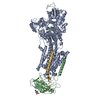
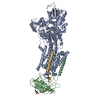
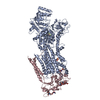
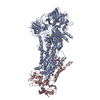

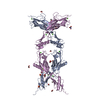


 PDBj
PDBj








